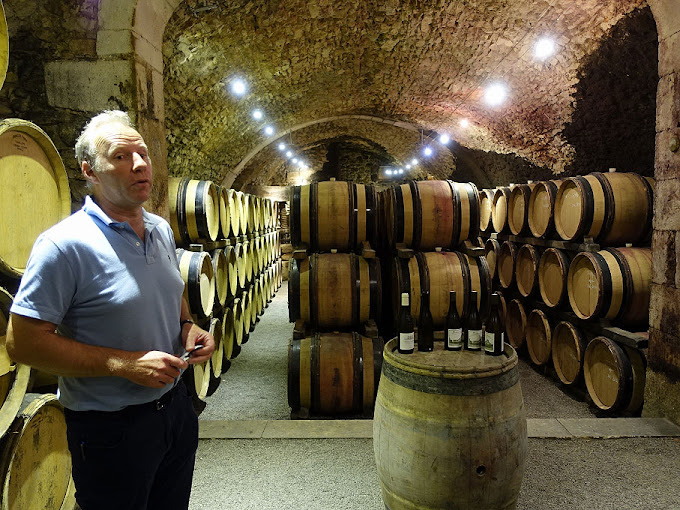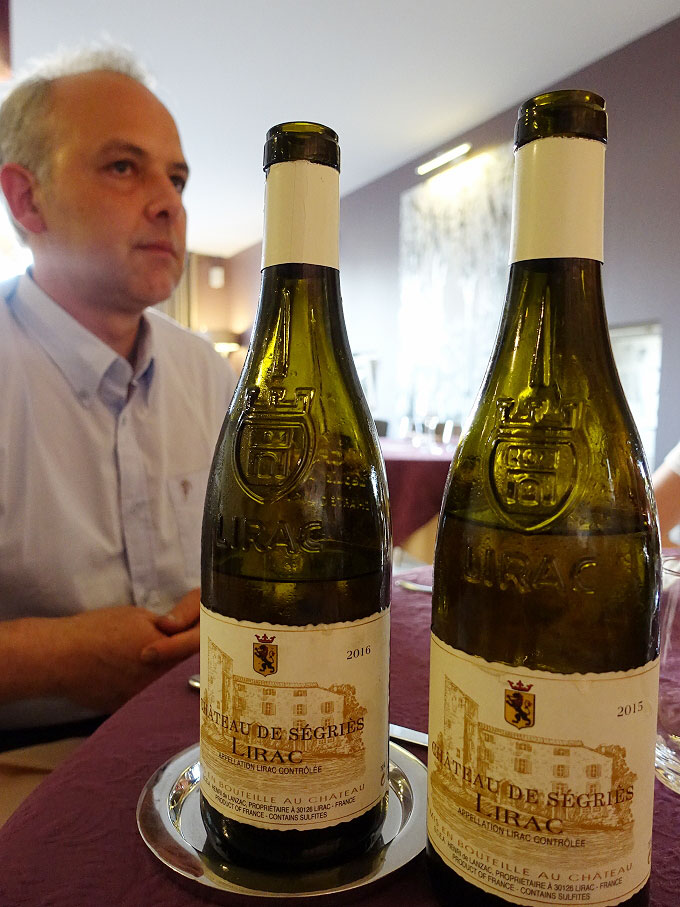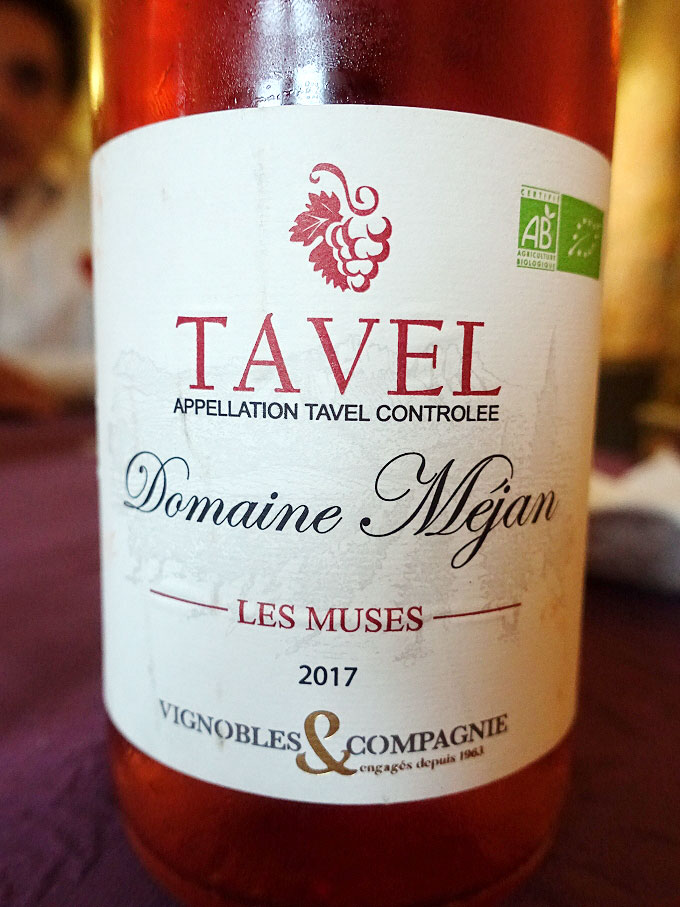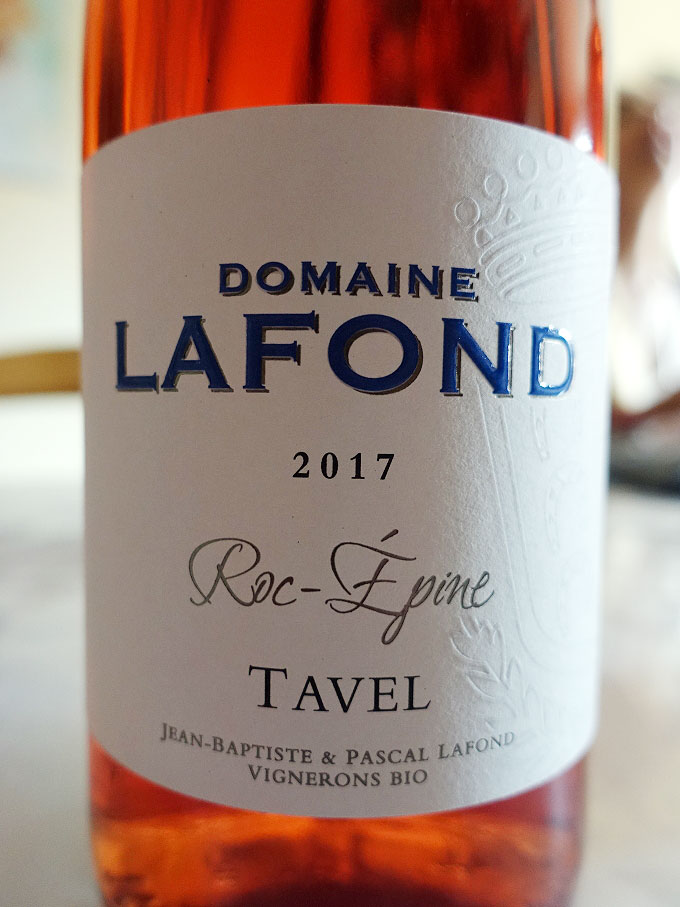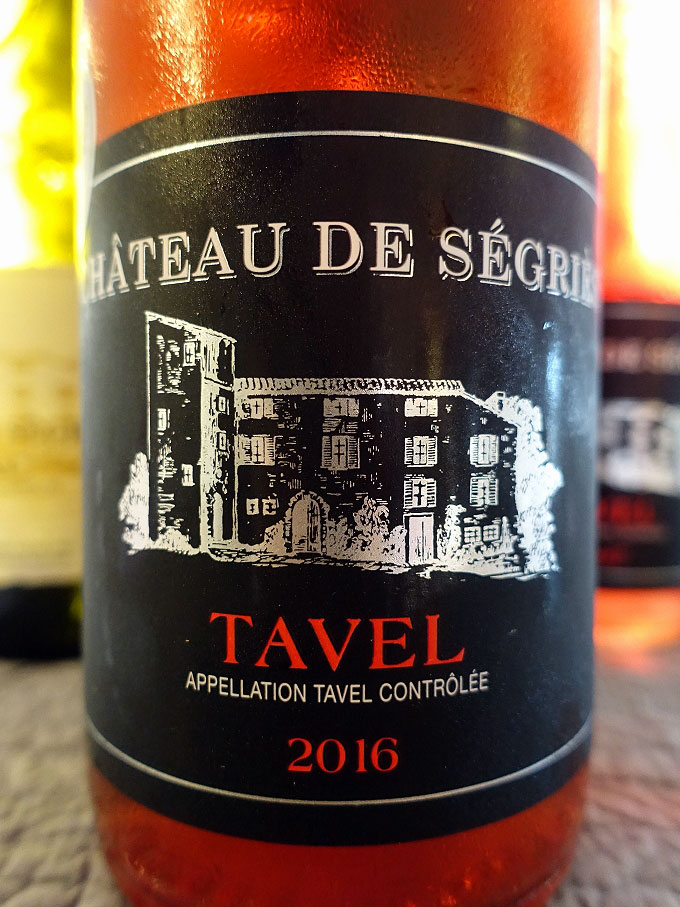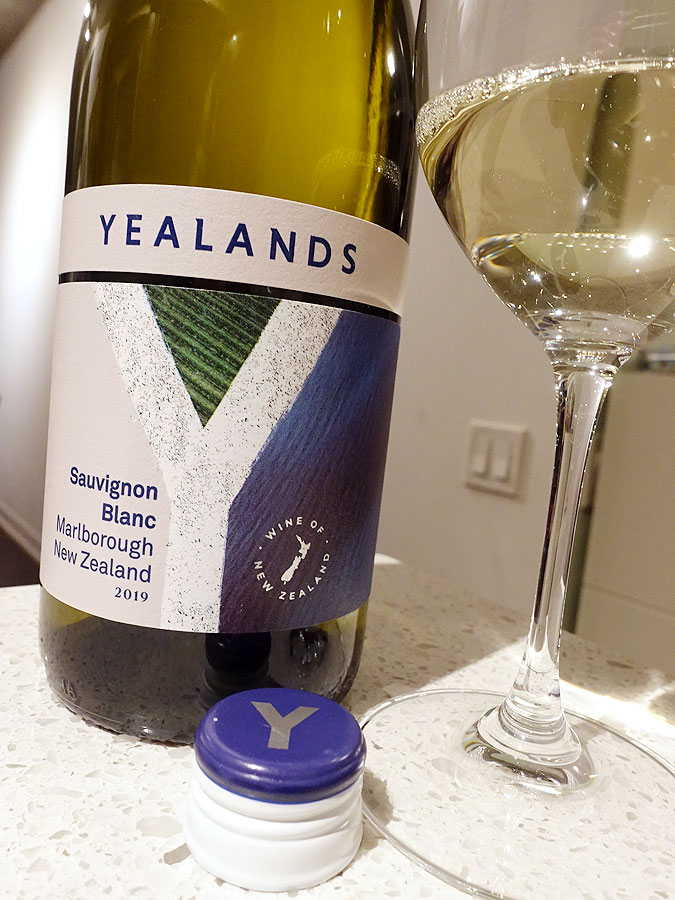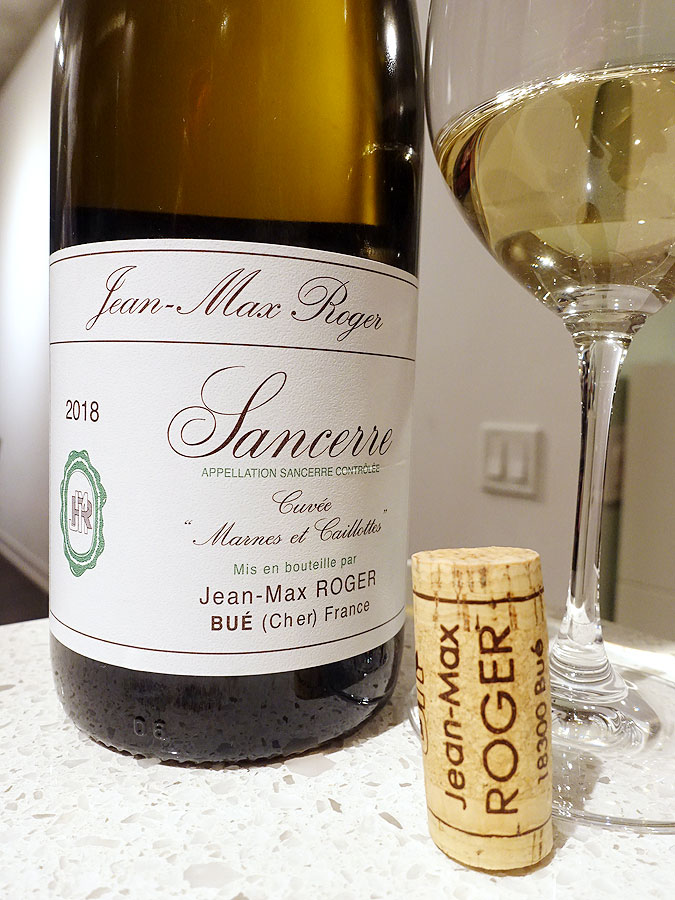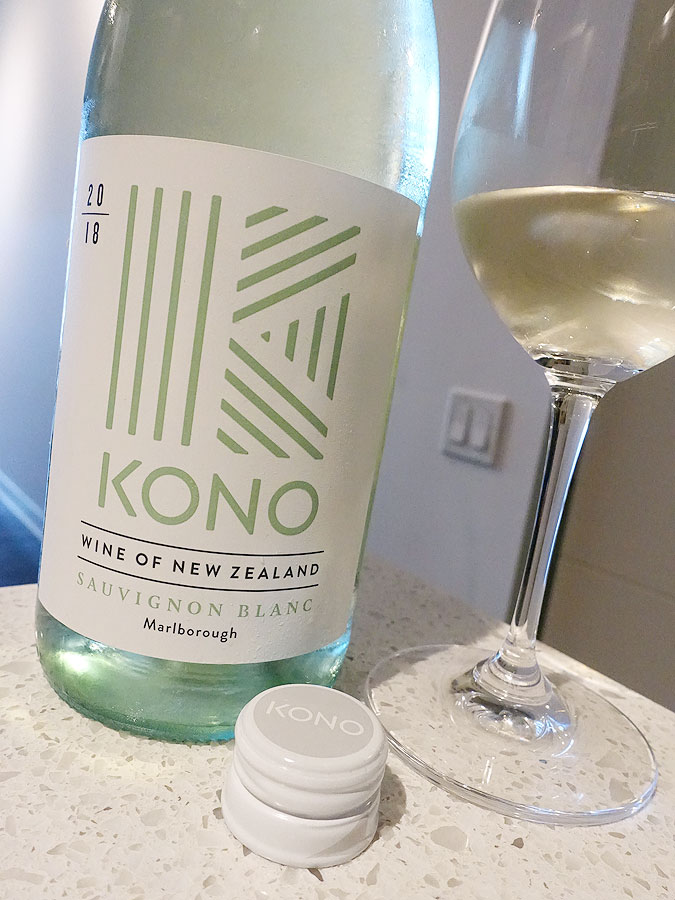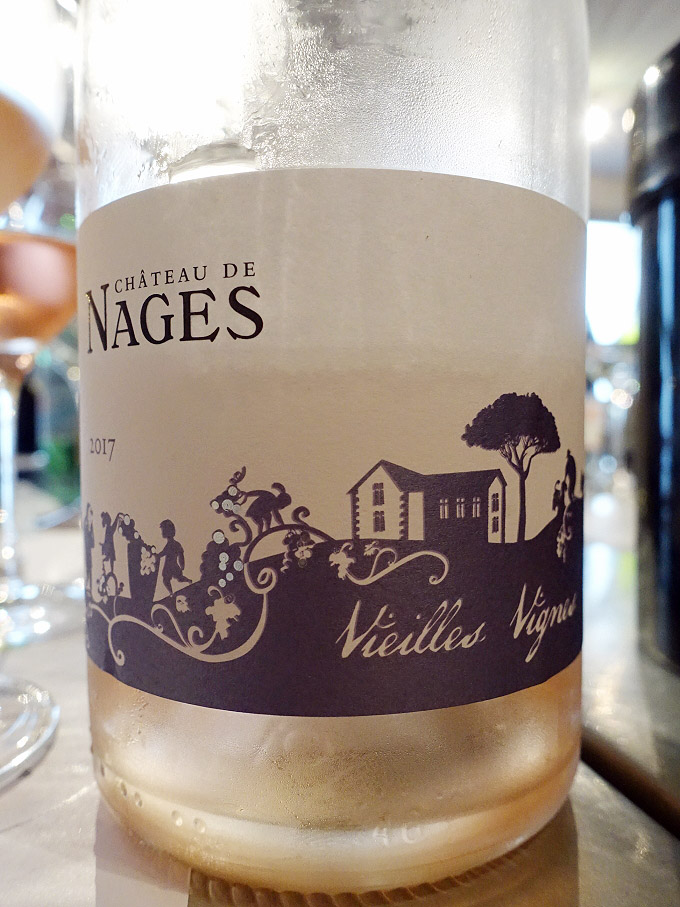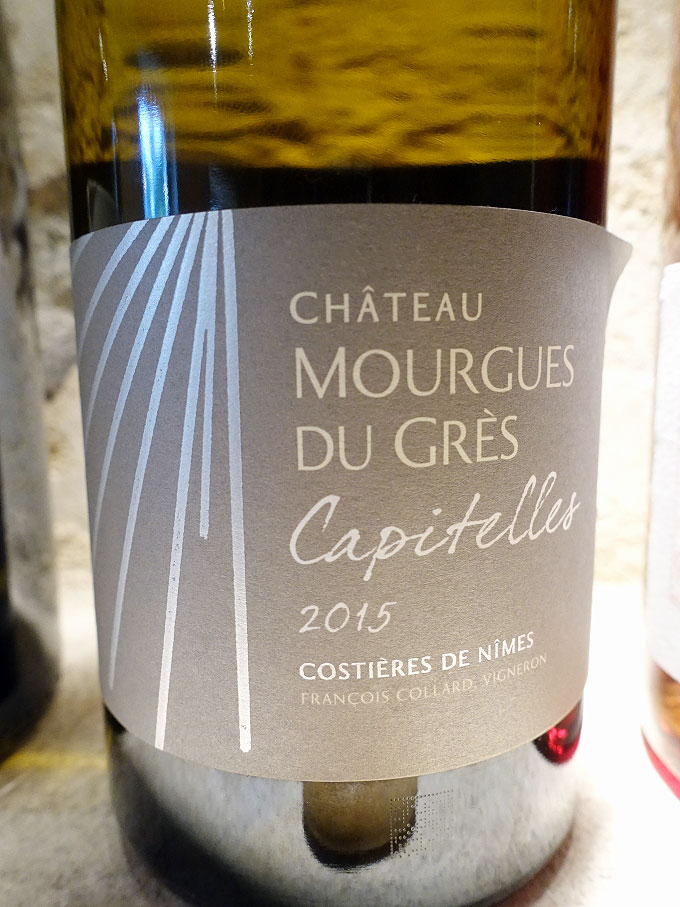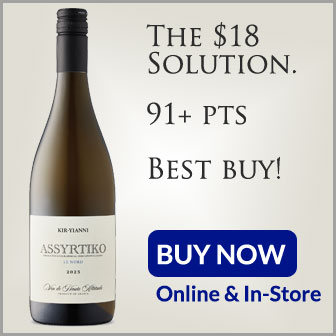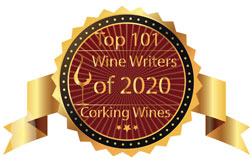The of our wine tour through the southern Rhône Valley took us through Lirac and Tavel AOCs. This day followed visits to Luberon and Ventoux, Cairanne, and Costières de Nîmes earlier in the week.
Tavel is located on the right bank of Rhône River. It achieved AOC status since 1937 and was actually the second to establish Cru status, right after the famous Châteauneuf-du-Pape. This southern Rhône Valley Cru is also unique in that it is the only Cru where all appellation wines must be rosé wine.
Vines have been cultivated in Tavel since the 5th century BC, first planted by the Greeks and then expanded by the Romans. The name "Villa Tavellis" first appeared in 13th century writings, eventually becoming Tavel. From 1737, a royal edict made it illegal to add foreign wines to those from Tavel and winemakers were also required to mark their barrels with "C.d.R." (Côte du Rhône), thus setting the precedent for what would become the AOC. In 1902, Tavel vineyard owners and winemakers formed a union to build the reputation of their rose wines. This eventually led to winemakers from Tavel petitioning the Gard to officially define the production area and become an AOC in 1937.
The soils in Tavel are mainly composed of alluvial, sandy, marly limestone, and crystalline & gravelly limestone, while the climate is Mediterranean where the sun and mistral winds are dominant. Nine grapes are permitted in Tavel, and no more than 60% of one varietal can be included in the final blend. Thus, all Tavel wines are blends, with Grenache often being the base. Traditionally, Tavel wines typically have a darker red colour due to the longer maceration times, where the grape skins have more contact with the must and creating wines that are more powerful and even somewhat tannic. However, there is a trend currently towards lighter rosés from Tavel due to the success of the lighter styles from Provence.
The introduction to Tavel actually began , during a lovely dinner at the Michelin-starred Entre Vigne & Garrigue with Thomas Giubbi of Vignobles & Compagnie, and Guillaume Demoulin of Château Trinquevedel. We tasted some of their latest Tavel wines, as well as got to try a 2014 Tavel that showed how well Tavel wines can age.
Vignobles & Compagnie was formed in 1963 when the growers of the department of the Gard came together with the aim of promoting Rhône Valley wines. The cellar, which was strategically located near the Pont du Gard, was also created at this time, is still in use today, and recently gained Heritage Status. The company has changed hands over the years, with Jean-Marie Berteau taking over the reins in 1972 and remaining in charge for 34 years. It was during this period that site underwent modernization and experienced major economic growth. In 1990, the Taillan Group took over activities and formed partnerships with local winegrowers. In 2011, Thomas Giubbi became the Managing Director at Vignobles & Compagnie and worked on grape supply to improve the quality of the wines, a task he continues to work on as he forges partnerships with many vineyards across the southern Rhône Valley. Vignobles & Compagnie is committed to working alongside its partner winegrowers to support, develop, and secure the future of these family estates by providing assistance in the vineyard, vinification, and the ageing process. The also help these estates market their wines. Thomas and his team are working towards exporting their wines to Ontario.
Guillaume Demoulin is the 4th generation of his family to farm the vineyards at Château Trinquevedel. His great-grandfather, Eugène, founded the 13th century estate in 1936 and began to the revive the site that was overrun with wild weeds. By 1960, the grapes were finally producing wine worthy of bottling. Today, there are 32 hectares of estate vineyards located in the hills Montagne Noire and planted to varietals such as Grenache, Cinsault, and Clairette. Soils consist primarily of sand and quartzite rounded stones. Wines are crafted to show typicity and quality of the Cru while using traditional and innovative wine growing techniques, while also respecting the environment.
In addition to the roles at their respective company's, Thomas and Guillaume are also co-presidents of the Syndicat Viticole de l’Appellation Tavel winemakers association. Among their more recent activities is the introduction of a new, modernized coat of arms that will be embossed on the neck of Tavel wines. This was a 2-year project that will finally be realized beginning with the 2018 vintage.
Entre Vigne & Garrigue is a small, family-owned bed & breakfast and restaurant created in a charming 17th century stone farmhouse located in the Rhône Valley countryside. The surroundings were quite serene and peaceful. The gourmet dinner was lovely and included a cheese cart like I've never seen before!
After a restful night, it was another early start, with more wet weather as we toured Tavel and Lirac. The first stop of the day was at the historic Tavel producer Château d’Aqueria. The fascinating history of Château d’Aqueria begins in 1595, when Louis Joseph d’Aqueria purchased the area of Tavel known as "Puy Sablonneux" from the monks at the Abbey in Villeneuve les Avignon. His son, Robert d'Aqueria, built a home that was transformed in the 18th century into the Château as it stands today. The estate has changed hands many times since the 18th century, all the while maintaining winegrowing activities because the terroir is very suitable for winegrowing. The estate has been in the same family for three generations now, when Jean Olivier purchased the estate 1919, and his son-in-law Paul de Bez began managing the estate in 1943, followed by his grandsons Bruno and Vincent de Bez, who today continue to run the estate.
Today, there are 60+ ha of vineyards surrounding the Château with light, sandy-clayey soils that are ideal for the production of rose's, while the limestone scree soils on their property just east of the Château in Lirac help produce white wines with outstanding fruit and depth. Château d’Aqueria practices organic fertilization and is High Environmental Value (HVE) certified, a system that promotes biodiversity and an environmentally-friendly agricultural approach involving pesticides, fertilization and water resource management. We met up with Vincent who gave us a tour of the facility, followed by a tasting of some of their latest wines. More wet weather lingered in the area, so we did not get a tour of the vineyards. However, Vincent told us we could drive to one of their nearby vineyards and it was amazingly littered with thousands (!) of rounded pebbles that allow the vines to grow in the best possible conditions thanks to the natural soil filter.
The next stop was at Domaine Coudoulis, a winery in Lirac located on a terrace overlooking the village of Saint-Laurent-des-Arbres. The family-owned and -operated estate winery was purchased by Bernard Callet in 1996 because he knew the site had fabulous soil. After 10 years of observing and learning about the site, Bernard called upon Patrick Hilaire, a man who had worked on some of the most famous vineyards, to create terroir-driven wines worthy of the Domaine. As Bernard explained, the vineyards have existed on this site since the 1960's on old terroir with its alluvial terraces that are rich in round pebbles - similar to Châteauneuf-du-Pape. Since that time, the building was rebuilt in 2011 into a modern facility with large concrete vats for fermentation and ageing, all the while transitioning their 25 hectares of vineyards to organic winemaking. Unfortunately, they do not make any rosés - as the rosé wines from this site are too dark compared to the current trend of light coloured rosés. They also currently do not make any white wines. However, there are plans to make some white wines as they planted some Grenache Blanc in 2017. Thus, after tasting their fine selection of red wines we took a tour of their modern winemaking facility and barrel cellar. We'll have to check back in a few years to see how Domaine Coudoulis fared with their Grenache Blanc.
Lunch was in the heart of Saint-Laurent-des-Arbres at Restaurant Le Papet and we were joined by Edouard Guerin, Director of Wines and Vineyards at Ogier, and Stéphane Soulier, Sales Manager at Les Vignerons de Tavel.
The story of Ogier begins with Ogier the Dane, an eccentric man who went off to fight in Basque country around 800 A.D. and on his way back home stopped in Massif Central. His stop became permanent and the Ogier name spread throughout the Rhône Valley. Antoine Ogier is a distant descendant of Ogier the Dane and he acquired an old cooperage in 1859. The main winery is in Chateauneu-du-Pape, where an old cooperage was converted into maturation cellars and is the largest in the Rhône Valley with its walls bearing witness to a history dating back to the Middle Ages. In 1995 with the arrival of Didier Couturier, the winery undergoes renewal, establishing relationships with winegrowers, and giving rise to the Ogier style - purity of fruit, freshness, and depth. During this time, a precision approach from vine to winemaking with a minimal interventionalist approach becomes the Ogier hallmark. Edouard was personable, friendly and showed plenty of passion for wine during lunch. I hope our paths cross again someday as the wines from Ogier were lovely. The Lirac Blanc and Tavel wines, one of each, we tasted from Ogier during lunch were fresh and delicious, especially the unreleased-at-the-time Lirac Blanc that ended up being one of my favourite wines of the day.
The cooperative cellar Les Vignerons de Tavel was founded in 1937, one year after the birth of AOP Tavel, when a few winemakers from decided to unite. France's first cooperative was inaugurated by the President of France, Albert Lebrun, in 1938 and was declared to be part of France's national heritage in 2013. Just weeks after my visit to Rhône, the cooperatives Les Vignerons de Tavel merged with the Cave des Vins de Cru in Lirac to become Cave des Vignerons de Tavel and Lirac that now represents 90 vine growers, 880 hectares of vines, and 35,000 hectolitres of production within AOC Tavel and Lirac, and other southern Rhône Valley appellations.
After lunch, we navigated the narrow streets of the village of Montfaucon, on the right bank of the Rhône River in Lirac, to visit the historic Château de Montfaucon. The first inhabitants of the exceptional Montfaucon rocky hill located across Châteauneuf-du-Pape can be traced back to the pre-historic era. In the 11th century, the castle's first watchtower was built as the Rhône River was a border between the French Kingdom and the Holy Roman German Empire. After the castle was extended in the Middle Ages, the King of France gave title to the first Baron of Montfaucon to the powerful Laudun family in 1420. 100 years later, a winery is built at the bottom of the Château and wine was made here until 1936, when it was converted to a barrel cellar for ageing. Between 1936 and 1995, even though the family cultivated the vines, the grapes were sold to a cooperative.
Current owner, Rodolphe de Pins, took over the family estate in 1995, rebuilt the winery, and began producing wine. His ancestors, the de Pertuis family, acquired the castle in 1766 and Joseph Gabriel de Pertuis became the Baron de Montfaucon. Joseph's son, Eugene, had a son named Louis who would become Baron Louis de Montfaucon. As they discovered with old wine labels with the name "1829 Vin de Monsieur le Baron de Montfaucon", they found that both Eugene and Louis were amateurs in wine. Baron Louis restored the Château and left the estate upon his death in 1910 to his young niece, Madeleine, since he never married or had children. When Madeleine married, she became Comtesse de Pins. She is also Rodolphe's grandmother.
Today, Château de Montfaucon has more than 60 ha of vines, including a recent purchase of a 7 ha Cru Lirac vineyard that has a plot containing 140-year-old Clairette vines. The vineyards of Château de Montfaucon have a diversity of soils - calcareous pebbelstone on silty sandy soil, soil with clay, and sandy soil - and exposures. Rodolphe has a natural approach to winemaking with minimal intervention, allowing the fruit to express its flavours. He also likes to make wines that have elegance, finesse, and complexity, while also being enjoyable and easy to drink.
White wines make up 10% of the production at Château de Montfaucon and all of the wines we tasted in the 500 year old cellar with Rodolphe were delicious, including a lovely back-vintage 2012 Clairette and 2011 Lirac white cuvée. Unfortunately, once again due to the rain, we were not able to see any of the vineyards. Rodolphe also invited us for a quick visit to his home - the Château (i.e. the real castle) located some minutes walking distance from the Domaine that was perched atop the village of Montfaucon, but the rains and lack of time would not allow it. All in all, this was a very fine visit that I would highly recommend to anyone visiting Lirac.
Lirac is located just north of Tavel and sits across the river from Châteauneuf-du-Pape, sharing many of the same characteristics as its famous neighbour. The area is very Mediterranean with plenty of sunshine and Mistral winds. Moreover, many of the vineyards in Lirac are laid out in terraces on hillsides among garrigue scrubland. There are three main soil types - limestone plateaus that covered with red clay and pebbles, ancient alluvial terraces made up of quartz pebbles and red clay atop a bed of sand, and sand laced with small pebbles. Due to soil diversity, many different grapes thrive here. Lirac achieved Cru status in 1947, making it the third oldest Rhône Valley Cru. At the time, it was known for producing easy drinking rose. Today, however, only 3% of the appellation's production is devoted to rosé (and 10% to white wines.)
The history of winemaking in Lirac goes back more than two thousand years. The small, nearby town of Roquemaure and its port became quite prosperous and powerful as it exported the wines of Cote du Rhône to Paris, England, and Holland. In the 16th century, the wines from Lirac gained a reputation for high quality wines that were served in the royal courts of France and abroad. In 1727, Lirac wines were the first from Rhône to be branded as C.d.R. to certify their origin, thus making Lirac Cru the original appellation. As mentioned earlier, the C.d.R. branding was applied to Tavel in 1737, and was later given to all wines from Côtes du Rhône.
The final winery visit of the day was in the heart of Tavel at Domaine Lafond Roc-Epine. The Lafond family has a rather long history of wine growing that began in 1780 with Pascal Odoyer, the governor of Tavel, was one of the first wine growers in his village and also the great-uncle of Jean-Pierre Lafond. In 1948, Valéry Taulier, the grandfather of current owner Pascal Lafond built the first private cellar of Tavel and contributed greatly to the growth of the Tavel appellation. In 1970, Jean-Pierre Lafond, Valéry Taulier’s son-in-law and a lover of race horses names his wine estate "Roc-Epine" in memory of the famous race horse, and Domaine Lafond Roc-Epine was born. In 1978, Pascal and his father Jean-Pierre Lafond begin bottling their own wines. Fast forward to 2009, they begin organic certification and eliminate the use of pesticides, herbicides and other chemical products, while only using copper and sulphite to protect the vineyards from the disease. In 2012, they received their organic certification and an emphasis to produce wine in the vineyard was strengthened. In 2015, the next generation of the Lafond family begins work at the winery with the arrival of Jean-Baptiste Lafond, Pascal's son, after he completed his BTS Viticulture-Oenology studies in Beaune. In addition to Tavel wines, they also produce Lirac appellation wines. In total, 3 hectares of vines are devoted white grape varieties, while 23 hectares are planted with red varietals, with soils consisting of mainly white rocks, sandy soil, and pebbles (alluvial soil). In terms of whites and rosé wines, they had a Lirac Blanc and two Tavel Rosés, and all three were delicious.
A fine day of wine tasting in Lirac and Tavel concluded at Entre Vigne & Garrigue, where Frédéric Grasset of Château de Ségriès joined us for dinner and to present his wines. Frédéric is the son-in-law of owner Henri de Lanzac. In 1994, Henri purchased the domain that included a partly ruined mansion from the 17th century that belonged to the noble Regis de Gatimel family since 1804. This makes Château de Ségriès one of the oldest estates in Lirac. Three generations of the family work at the Château, including the 75-year-old Henri. His son, Laurent, is the viticulturist and winemaker, while his daughter Anna, wife of Frédéric, also works at the winery. Together, they manage 58 ha of old vines averaging 80 years of age on mainly clay-limestone soils. Only a small portion of this acreage is devoted to AOP Lirac white wines, while 11 ha in a single vineyard in Tavel. Château de Ségriès only makes one Lirac Blanc and one Tavel wine, so it was nice to try the two most recent vintages of each wine during dinner.
Looking back on this day, Tavel was everything I expected it to be - traditionally deeply coloured, fruity and dry, high quality rose wines, with some having slightly tannic and structured characters that some might even call light red wines, while others were made in the more trendier Provençal style that is pale coloured and fresh. Tavel can be enjoyed on its own or paired with salad, poultry, or hearty fish.
Lirac, on the other hand, was an eye-opener for me. It is one of the least known Crus, and even I didn't know much about it before arriving. Lirac appellation white wines are made primarily with varietals such as Grenache Blanc, Clairette, Roussanne, and Bourboulenc, and sometimes includes Marsanne, Viognier, or Picpoul. The white wines were fresh and clean, with some minerality and structure, and could be aged for a number of years. All-in-all, I was very impressed with the white wines from Lirac.
Overall, I was very happy with my visit to the Southern Rhône Valley. I learned many new things over the four days while also meeting some fine individuals who are shaping the future of the wines from Luberon, Ventoux, Cairanne, Costières de Nîmes, Tavel, and Lirac.
Blend of 70% Grenache, 20% Cinsault, 5% Mourvedre, 3% Syrah, and 2% Clairette from sandy soil, clay, and rolled pebbles, alluvial deposits. Medium+ intensity nose offers red fruit, red cherry, strawberry, and herbal aromas. The medium+ bodied palate is spicy with fresh acids and pleasing red berried aroma replays. Lightly tannic, dry, with some structure, and very good finish length. Score: 88 pts
VIGNOBLES & COMPAGNIE RÉSERVE DES CHASTELLES TAVEL 2017 - AC, Rhône, France (XD) - 12 €
Grenache and Syrah blend from gravel, clay and quartz pebbles soils. Medium-high intensity nose with plenty of red fruits - currant, strawberry, cherry and some red pepper nuances. It is full-bodied, dry and structured on the palate with candied red berry flavours. There's some tannic structure and the finish length is very good. Score: 89 pts
Agent: N/A
CHÂTEAU TRINQUEVEDEL TAVEL 2017 - AC, Rhône, France (#729947) (XD) - 12.5 €
Blend of Grenache, Syrah, Cinsault, Clairette, Bourboulenc, and Mourvèdre, this has fruity medium+ intensity aromas of rhubarb and strawberry. It is medium-full bodied, dry and spicy on the palate with fresh acids and nice aroma replays joined by hints of orange. Structured with some tannins. Very good finish length. Score: 89 pts
CHÂTEAU TRINQUEVEDEL LES VIGNES D'EUGÈNE TAVEL 2014 - AC, Rhône, France (XD) - 15 €
Blend of Grenache, Clairette and Syrah from 80-85 year old vines and one-third oak aged, this has a subtle orange, red berry and spice nose with touches of floral. It is medium-full bodied and nicely integrated on the palate with balanced acids, and pretty rose floral and cherry characters. Somewhat structured and the finish length is very good. Holding up quite well at this age. Score: 89+ pts
Agent: Barrel Select (ON)
CHÂTEAU D'AQUERIA LIRAC BLANC 2017 - AC, Rhône, France (XD) - 12 €
40% Grenache Blanc, 25% Bourboulenc, 16% Clairette, 12% Roussanne, and 7% Viognier from limestone scree soils. Open, fragrant and fresh with herbally, lemony, and anise aromas. Medium-bodied with a slightly oily texture. Nice aroma replays on the palate plus notable anise, fennel, and pear notes. There's some structure a nice chalky mineral mid-palate. Shows finesse on the finish, with excellent length. Score: 89 pts
CHÂTEAU D'AQUERIA TAVEL 2017 - AP, Rhône, France (#319368) (XD) - $23.95
45% Grenache, 20% Clairette, 15% Cinsault, 8% Mourvèdre, 6% Syrah, 4% Bourboulenc, and 2% Picpoul from sandy clayey hillsides. The subtle nose is fruity and a touch candied, offering red berry, cherry, currant, and citrus aromas. It's medium-full bodied with nicely balanced citrusy aroma replays. Acids are very good. The long finish is crisp and spicy with a fine mineral note. Score: 89 pts
Agent: Noble Estates Wine & Spirits (ON), LBV International (QC)
DOMAINE COUDOULIS EVIDENCE LIRAC 2016 - AP, Rhône, France (XD) - 9 €
Blend of Grenache, Syrah, Mourvèdre (15%), Carignan, and Cinsault. Medium-high intensity nose is meaty with floral, dark cherry, blackberry, licorice, and black spice aromas. The spicy medium+ bodied palate has nice dark cherry/berry and oak spice notes. Well-structured with refined tannins. Nicely balanced overall with good acidity. Finish length is very good. Score: 89 pts
Agent: Azureau Wines & Spirits (ON)
OGIER LOU CAMINÉ LIRAC BLANC 2017 - AC, Rhône, France (XD)
First vintage of this wine. Blend of Clairette and Grenache Blanc from 5 to 80 year-old vines that was barrel-fermented and barrel-aged. It has medium-high intensity aromas that are clean and elegant with mineral, lemon/lime, herbs and anise notes, all of which come through on the medium+ bodied palate with hints of saline minerality. Acids are fresh and the finish length is excellent. Score: 90 pts
OGIER ETAMINES TAVEL 2017 - AC, Rhône, France (XD)
Pretty, medium-high intensity nose of strawberry, spice, currant, and cherry aromas. It is medium-full bodied with spicy aroma replays on the palate, fresh acids, and very good finish length. Score: 88 pts
Agent: Select Wines (ON), Sélect Vins AdVini (QC)
DOMAINE DU VIEIL AVEN TAVEL 2017 - AC, Rhône, France (XD) - $18.70
Medium+ intensity nose is spicy with red currant, cherry, and strawberry aromas. The palate is full-ish with gentle tannins and juicy acids that support the nicely dry aroma replays. Very good finish length. Score: 88 pts
Agent: Louis Roche (QC)
DOMAINE DES CARTERESSES TAVEL ROSÉ 2017 - AC, Rhône, France (#739474) (XD) - $18.95
The medium-high intensity nose is fresh has ripe aromas of strawberry, cherry, and rhubarb. It's medium-full bodied on the palate with a rounded mouthfeel. Touch candied cherry flavour, plus aroma replays on the flavour profile. Juicy acids, smooth tannins, and very good length on the finish. Score: 88 pts
Agent: Dionysus Wines & Spirits (ON), Vin Conseil (QC)
CHÂTEAU DE MONTFAUCON COMTESSE MADELEINE LIRAC BLANC 2017 - AC, Rhône, France (XD) - 13.5 €
Just bottled. Blend of Marsanne (40%), Clairette, Grenache Blanc, Picpoul, and Viognier. Medium-high intensity aromas are fresh and ripe with white and yellow florals, and key lime pie. On the medium-bodied palate, it has nice, ripe aroma replays supported by bright and lively acids. Anise, herbs, and lime notes linger on the long finish. Barrel-fermented and aged, yet oak is very subtle. Should drink well for at least half a dozen years. Score: 89 pts
CHÂTEAU DE MONTFAUCON VIN DE MADAME LA COMTESSE LIRAC BLANC 2012 - AP, Rhône, France (XD)
Limited production. 100% Clairette barrel-fermented from a small 1.3 acre vineyard first planted in 1870 - one of the oldest in Rhône Valley. Complex, medium-high intensity nose is exotic and a touch oxidative with nutty, pear and fennel aromas. Spicy palate is still showing freshness with very nice aroma replays and some mineral notes adding complexity. Shows finesse on the long, intense finish. 2012 was the first vintage of this wine. Score: 91 pts
Agent: Nicholas Pearce Wines (ON)
DOMAINE LAFOND ROC-ÉPINE LIRAC BLANC 2017 - AP, Rhône, France (XD) - 10 €
This blend of 50% Grenache Blanc, 30% Roussanne, and 20% Viognier that has medium+ intensity aromas of fennel, anise, lemony citrus, and herbs. Acids are fresh and bright on the medium-bodied palate with nice aroma replays on the flavour profile. Clean and crisp with hints of mineral on the long finish. Score: 88+ pts
DOMAINE LAFOND ROC-ÉPINE TAVEL 2017 - AP, Rhône, France (#950709) (XD) - 10 €
60% Grenache with equal parts Syrah and Cinsault. Medium-high intensity nose is pretty with freshly picked, ripe strawberry, rhubarb, and cherry aromas. The medium+ bodied palate is fleshy, a touch candied, but dry, with nice aroma replays. It has juicy acids, a spicy mid-palate, and very good finish length. Score: 88 pts
Agent: Hobbs & Co. (ON)
CHÂTEAU SÉGRIÈS LIRAC BLANC 2015 - AC, Rhône, France (XD) - 12 €
A blend of 50% Clairette, 30% Ugni Blanc, 10% Roussanne, 5% Bourboulenc, and 5% Picpoul that is 30% barrel-fermented. Subtle herbs, fennel, and lemon aromas. It is medium-full bodied and creamy with nice pear and herbals flavours. Crunchy fruit with fresh acidity. Finish length is very good. Score: 89 pts
CHÂTEAU SÉGRIÈS TAVEL 2016 - AC, Rhône, France (XD) - 12 €
Blend of 50% Grenache, 30% Cinsault, 10% Syrah, and 10% Clairette. Medium+ intensity nose offers cherry, strawberry, and currant aromas, with much of the same on the spicy, full-bodied palate. It has some tannic structure, while acids and finish length are both very good. Score: 89 pts
Agent: N/A
Tavel is located on the right bank of Rhône River. It achieved AOC status since 1937 and was actually the second to establish Cru status, right after the famous Châteauneuf-du-Pape. This southern Rhône Valley Cru is also unique in that it is the only Cru where all appellation wines must be rosé wine.
Vines have been cultivated in Tavel since the 5th century BC, first planted by the Greeks and then expanded by the Romans. The name "Villa Tavellis" first appeared in 13th century writings, eventually becoming Tavel. From 1737, a royal edict made it illegal to add foreign wines to those from Tavel and winemakers were also required to mark their barrels with "C.d.R." (Côte du Rhône), thus setting the precedent for what would become the AOC. In 1902, Tavel vineyard owners and winemakers formed a union to build the reputation of their rose wines. This eventually led to winemakers from Tavel petitioning the Gard to officially define the production area and become an AOC in 1937.
The soils in Tavel are mainly composed of alluvial, sandy, marly limestone, and crystalline & gravelly limestone, while the climate is Mediterranean where the sun and mistral winds are dominant. Nine grapes are permitted in Tavel, and no more than 60% of one varietal can be included in the final blend. Thus, all Tavel wines are blends, with Grenache often being the base. Traditionally, Tavel wines typically have a darker red colour due to the longer maceration times, where the grape skins have more contact with the must and creating wines that are more powerful and even somewhat tannic. However, there is a trend currently towards lighter rosés from Tavel due to the success of the lighter styles from Provence.
The introduction to Tavel actually began , during a lovely dinner at the Michelin-starred Entre Vigne & Garrigue with Thomas Giubbi of Vignobles & Compagnie, and Guillaume Demoulin of Château Trinquevedel. We tasted some of their latest Tavel wines, as well as got to try a 2014 Tavel that showed how well Tavel wines can age.
Vignobles & Compagnie was formed in 1963 when the growers of the department of the Gard came together with the aim of promoting Rhône Valley wines. The cellar, which was strategically located near the Pont du Gard, was also created at this time, is still in use today, and recently gained Heritage Status. The company has changed hands over the years, with Jean-Marie Berteau taking over the reins in 1972 and remaining in charge for 34 years. It was during this period that site underwent modernization and experienced major economic growth. In 1990, the Taillan Group took over activities and formed partnerships with local winegrowers. In 2011, Thomas Giubbi became the Managing Director at Vignobles & Compagnie and worked on grape supply to improve the quality of the wines, a task he continues to work on as he forges partnerships with many vineyards across the southern Rhône Valley. Vignobles & Compagnie is committed to working alongside its partner winegrowers to support, develop, and secure the future of these family estates by providing assistance in the vineyard, vinification, and the ageing process. The also help these estates market their wines. Thomas and his team are working towards exporting their wines to Ontario.
Guillaume Demoulin is the 4th generation of his family to farm the vineyards at Château Trinquevedel. His great-grandfather, Eugène, founded the 13th century estate in 1936 and began to the revive the site that was overrun with wild weeds. By 1960, the grapes were finally producing wine worthy of bottling. Today, there are 32 hectares of estate vineyards located in the hills Montagne Noire and planted to varietals such as Grenache, Cinsault, and Clairette. Soils consist primarily of sand and quartzite rounded stones. Wines are crafted to show typicity and quality of the Cru while using traditional and innovative wine growing techniques, while also respecting the environment.
In addition to the roles at their respective company's, Thomas and Guillaume are also co-presidents of the Syndicat Viticole de l’Appellation Tavel winemakers association. Among their more recent activities is the introduction of a new, modernized coat of arms that will be embossed on the neck of Tavel wines. This was a 2-year project that will finally be realized beginning with the 2018 vintage.
Entre Vigne & Garrigue is a small, family-owned bed & breakfast and restaurant created in a charming 17th century stone farmhouse located in the Rhône Valley countryside. The surroundings were quite serene and peaceful. The gourmet dinner was lovely and included a cheese cart like I've never seen before!
After a restful night, it was another early start, with more wet weather as we toured Tavel and Lirac. The first stop of the day was at the historic Tavel producer Château d’Aqueria. The fascinating history of Château d’Aqueria begins in 1595, when Louis Joseph d’Aqueria purchased the area of Tavel known as "Puy Sablonneux" from the monks at the Abbey in Villeneuve les Avignon. His son, Robert d'Aqueria, built a home that was transformed in the 18th century into the Château as it stands today. The estate has changed hands many times since the 18th century, all the while maintaining winegrowing activities because the terroir is very suitable for winegrowing. The estate has been in the same family for three generations now, when Jean Olivier purchased the estate 1919, and his son-in-law Paul de Bez began managing the estate in 1943, followed by his grandsons Bruno and Vincent de Bez, who today continue to run the estate.
Today, there are 60+ ha of vineyards surrounding the Château with light, sandy-clayey soils that are ideal for the production of rose's, while the limestone scree soils on their property just east of the Château in Lirac help produce white wines with outstanding fruit and depth. Château d’Aqueria practices organic fertilization and is High Environmental Value (HVE) certified, a system that promotes biodiversity and an environmentally-friendly agricultural approach involving pesticides, fertilization and water resource management. We met up with Vincent who gave us a tour of the facility, followed by a tasting of some of their latest wines. More wet weather lingered in the area, so we did not get a tour of the vineyards. However, Vincent told us we could drive to one of their nearby vineyards and it was amazingly littered with thousands (!) of rounded pebbles that allow the vines to grow in the best possible conditions thanks to the natural soil filter.
The next stop was at Domaine Coudoulis, a winery in Lirac located on a terrace overlooking the village of Saint-Laurent-des-Arbres. The family-owned and -operated estate winery was purchased by Bernard Callet in 1996 because he knew the site had fabulous soil. After 10 years of observing and learning about the site, Bernard called upon Patrick Hilaire, a man who had worked on some of the most famous vineyards, to create terroir-driven wines worthy of the Domaine. As Bernard explained, the vineyards have existed on this site since the 1960's on old terroir with its alluvial terraces that are rich in round pebbles - similar to Châteauneuf-du-Pape. Since that time, the building was rebuilt in 2011 into a modern facility with large concrete vats for fermentation and ageing, all the while transitioning their 25 hectares of vineyards to organic winemaking. Unfortunately, they do not make any rosés - as the rosé wines from this site are too dark compared to the current trend of light coloured rosés. They also currently do not make any white wines. However, there are plans to make some white wines as they planted some Grenache Blanc in 2017. Thus, after tasting their fine selection of red wines we took a tour of their modern winemaking facility and barrel cellar. We'll have to check back in a few years to see how Domaine Coudoulis fared with their Grenache Blanc.
Lunch was in the heart of Saint-Laurent-des-Arbres at Restaurant Le Papet and we were joined by Edouard Guerin, Director of Wines and Vineyards at Ogier, and Stéphane Soulier, Sales Manager at Les Vignerons de Tavel.
The story of Ogier begins with Ogier the Dane, an eccentric man who went off to fight in Basque country around 800 A.D. and on his way back home stopped in Massif Central. His stop became permanent and the Ogier name spread throughout the Rhône Valley. Antoine Ogier is a distant descendant of Ogier the Dane and he acquired an old cooperage in 1859. The main winery is in Chateauneu-du-Pape, where an old cooperage was converted into maturation cellars and is the largest in the Rhône Valley with its walls bearing witness to a history dating back to the Middle Ages. In 1995 with the arrival of Didier Couturier, the winery undergoes renewal, establishing relationships with winegrowers, and giving rise to the Ogier style - purity of fruit, freshness, and depth. During this time, a precision approach from vine to winemaking with a minimal interventionalist approach becomes the Ogier hallmark. Edouard was personable, friendly and showed plenty of passion for wine during lunch. I hope our paths cross again someday as the wines from Ogier were lovely. The Lirac Blanc and Tavel wines, one of each, we tasted from Ogier during lunch were fresh and delicious, especially the unreleased-at-the-time Lirac Blanc that ended up being one of my favourite wines of the day.
The cooperative cellar Les Vignerons de Tavel was founded in 1937, one year after the birth of AOP Tavel, when a few winemakers from decided to unite. France's first cooperative was inaugurated by the President of France, Albert Lebrun, in 1938 and was declared to be part of France's national heritage in 2013. Just weeks after my visit to Rhône, the cooperatives Les Vignerons de Tavel merged with the Cave des Vins de Cru in Lirac to become Cave des Vignerons de Tavel and Lirac that now represents 90 vine growers, 880 hectares of vines, and 35,000 hectolitres of production within AOC Tavel and Lirac, and other southern Rhône Valley appellations.
After lunch, we navigated the narrow streets of the village of Montfaucon, on the right bank of the Rhône River in Lirac, to visit the historic Château de Montfaucon. The first inhabitants of the exceptional Montfaucon rocky hill located across Châteauneuf-du-Pape can be traced back to the pre-historic era. In the 11th century, the castle's first watchtower was built as the Rhône River was a border between the French Kingdom and the Holy Roman German Empire. After the castle was extended in the Middle Ages, the King of France gave title to the first Baron of Montfaucon to the powerful Laudun family in 1420. 100 years later, a winery is built at the bottom of the Château and wine was made here until 1936, when it was converted to a barrel cellar for ageing. Between 1936 and 1995, even though the family cultivated the vines, the grapes were sold to a cooperative.
Current owner, Rodolphe de Pins, took over the family estate in 1995, rebuilt the winery, and began producing wine. His ancestors, the de Pertuis family, acquired the castle in 1766 and Joseph Gabriel de Pertuis became the Baron de Montfaucon. Joseph's son, Eugene, had a son named Louis who would become Baron Louis de Montfaucon. As they discovered with old wine labels with the name "1829 Vin de Monsieur le Baron de Montfaucon", they found that both Eugene and Louis were amateurs in wine. Baron Louis restored the Château and left the estate upon his death in 1910 to his young niece, Madeleine, since he never married or had children. When Madeleine married, she became Comtesse de Pins. She is also Rodolphe's grandmother.
Today, Château de Montfaucon has more than 60 ha of vines, including a recent purchase of a 7 ha Cru Lirac vineyard that has a plot containing 140-year-old Clairette vines. The vineyards of Château de Montfaucon have a diversity of soils - calcareous pebbelstone on silty sandy soil, soil with clay, and sandy soil - and exposures. Rodolphe has a natural approach to winemaking with minimal intervention, allowing the fruit to express its flavours. He also likes to make wines that have elegance, finesse, and complexity, while also being enjoyable and easy to drink.
White wines make up 10% of the production at Château de Montfaucon and all of the wines we tasted in the 500 year old cellar with Rodolphe were delicious, including a lovely back-vintage 2012 Clairette and 2011 Lirac white cuvée. Unfortunately, once again due to the rain, we were not able to see any of the vineyards. Rodolphe also invited us for a quick visit to his home - the Château (i.e. the real castle) located some minutes walking distance from the Domaine that was perched atop the village of Montfaucon, but the rains and lack of time would not allow it. All in all, this was a very fine visit that I would highly recommend to anyone visiting Lirac.
Lirac is located just north of Tavel and sits across the river from Châteauneuf-du-Pape, sharing many of the same characteristics as its famous neighbour. The area is very Mediterranean with plenty of sunshine and Mistral winds. Moreover, many of the vineyards in Lirac are laid out in terraces on hillsides among garrigue scrubland. There are three main soil types - limestone plateaus that covered with red clay and pebbles, ancient alluvial terraces made up of quartz pebbles and red clay atop a bed of sand, and sand laced with small pebbles. Due to soil diversity, many different grapes thrive here. Lirac achieved Cru status in 1947, making it the third oldest Rhône Valley Cru. At the time, it was known for producing easy drinking rose. Today, however, only 3% of the appellation's production is devoted to rosé (and 10% to white wines.)
The history of winemaking in Lirac goes back more than two thousand years. The small, nearby town of Roquemaure and its port became quite prosperous and powerful as it exported the wines of Cote du Rhône to Paris, England, and Holland. In the 16th century, the wines from Lirac gained a reputation for high quality wines that were served in the royal courts of France and abroad. In 1727, Lirac wines were the first from Rhône to be branded as C.d.R. to certify their origin, thus making Lirac Cru the original appellation. As mentioned earlier, the C.d.R. branding was applied to Tavel in 1737, and was later given to all wines from Côtes du Rhône.
The final winery visit of the day was in the heart of Tavel at Domaine Lafond Roc-Epine. The Lafond family has a rather long history of wine growing that began in 1780 with Pascal Odoyer, the governor of Tavel, was one of the first wine growers in his village and also the great-uncle of Jean-Pierre Lafond. In 1948, Valéry Taulier, the grandfather of current owner Pascal Lafond built the first private cellar of Tavel and contributed greatly to the growth of the Tavel appellation. In 1970, Jean-Pierre Lafond, Valéry Taulier’s son-in-law and a lover of race horses names his wine estate "Roc-Epine" in memory of the famous race horse, and Domaine Lafond Roc-Epine was born. In 1978, Pascal and his father Jean-Pierre Lafond begin bottling their own wines. Fast forward to 2009, they begin organic certification and eliminate the use of pesticides, herbicides and other chemical products, while only using copper and sulphite to protect the vineyards from the disease. In 2012, they received their organic certification and an emphasis to produce wine in the vineyard was strengthened. In 2015, the next generation of the Lafond family begins work at the winery with the arrival of Jean-Baptiste Lafond, Pascal's son, after he completed his BTS Viticulture-Oenology studies in Beaune. In addition to Tavel wines, they also produce Lirac appellation wines. In total, 3 hectares of vines are devoted white grape varieties, while 23 hectares are planted with red varietals, with soils consisting of mainly white rocks, sandy soil, and pebbles (alluvial soil). In terms of whites and rosé wines, they had a Lirac Blanc and two Tavel Rosés, and all three were delicious.
A fine day of wine tasting in Lirac and Tavel concluded at Entre Vigne & Garrigue, where Frédéric Grasset of Château de Ségriès joined us for dinner and to present his wines. Frédéric is the son-in-law of owner Henri de Lanzac. In 1994, Henri purchased the domain that included a partly ruined mansion from the 17th century that belonged to the noble Regis de Gatimel family since 1804. This makes Château de Ségriès one of the oldest estates in Lirac. Three generations of the family work at the Château, including the 75-year-old Henri. His son, Laurent, is the viticulturist and winemaker, while his daughter Anna, wife of Frédéric, also works at the winery. Together, they manage 58 ha of old vines averaging 80 years of age on mainly clay-limestone soils. Only a small portion of this acreage is devoted to AOP Lirac white wines, while 11 ha in a single vineyard in Tavel. Château de Ségriès only makes one Lirac Blanc and one Tavel wine, so it was nice to try the two most recent vintages of each wine during dinner.
Looking back on this day, Tavel was everything I expected it to be - traditionally deeply coloured, fruity and dry, high quality rose wines, with some having slightly tannic and structured characters that some might even call light red wines, while others were made in the more trendier Provençal style that is pale coloured and fresh. Tavel can be enjoyed on its own or paired with salad, poultry, or hearty fish.
Lirac, on the other hand, was an eye-opener for me. It is one of the least known Crus, and even I didn't know much about it before arriving. Lirac appellation white wines are made primarily with varietals such as Grenache Blanc, Clairette, Roussanne, and Bourboulenc, and sometimes includes Marsanne, Viognier, or Picpoul. The white wines were fresh and clean, with some minerality and structure, and could be aged for a number of years. All-in-all, I was very impressed with the white wines from Lirac.
Overall, I was very happy with my visit to the Southern Rhône Valley. I learned many new things over the four days while also meeting some fine individuals who are shaping the future of the wines from Luberon, Ventoux, Cairanne, Costières de Nîmes, Tavel, and Lirac.
Tasting Notes:
VIGNOBLES & COMPAGNIE DOMAINE MÉJAN LES MUSES TAVEL 2017 - AC, Rhône, France (XD)Blend of 70% Grenache, 20% Cinsault, 5% Mourvedre, 3% Syrah, and 2% Clairette from sandy soil, clay, and rolled pebbles, alluvial deposits. Medium+ intensity nose offers red fruit, red cherry, strawberry, and herbal aromas. The medium+ bodied palate is spicy with fresh acids and pleasing red berried aroma replays. Lightly tannic, dry, with some structure, and very good finish length. Score: 88 pts
VIGNOBLES & COMPAGNIE RÉSERVE DES CHASTELLES TAVEL 2017 - AC, Rhône, France (XD) - 12 €
Grenache and Syrah blend from gravel, clay and quartz pebbles soils. Medium-high intensity nose with plenty of red fruits - currant, strawberry, cherry and some red pepper nuances. It is full-bodied, dry and structured on the palate with candied red berry flavours. There's some tannic structure and the finish length is very good. Score: 89 pts
Agent: N/A
CHÂTEAU TRINQUEVEDEL TAVEL 2017 - AC, Rhône, France (#729947) (XD) - 12.5 €
Blend of Grenache, Syrah, Cinsault, Clairette, Bourboulenc, and Mourvèdre, this has fruity medium+ intensity aromas of rhubarb and strawberry. It is medium-full bodied, dry and spicy on the palate with fresh acids and nice aroma replays joined by hints of orange. Structured with some tannins. Very good finish length. Score: 89 pts
CHÂTEAU TRINQUEVEDEL LES VIGNES D'EUGÈNE TAVEL 2014 - AC, Rhône, France (XD) - 15 €
Blend of Grenache, Clairette and Syrah from 80-85 year old vines and one-third oak aged, this has a subtle orange, red berry and spice nose with touches of floral. It is medium-full bodied and nicely integrated on the palate with balanced acids, and pretty rose floral and cherry characters. Somewhat structured and the finish length is very good. Holding up quite well at this age. Score: 89+ pts
Agent: Barrel Select (ON)
CHÂTEAU D'AQUERIA LIRAC BLANC 2017 - AC, Rhône, France (XD) - 12 €
40% Grenache Blanc, 25% Bourboulenc, 16% Clairette, 12% Roussanne, and 7% Viognier from limestone scree soils. Open, fragrant and fresh with herbally, lemony, and anise aromas. Medium-bodied with a slightly oily texture. Nice aroma replays on the palate plus notable anise, fennel, and pear notes. There's some structure a nice chalky mineral mid-palate. Shows finesse on the finish, with excellent length. Score: 89 pts
CHÂTEAU D'AQUERIA TAVEL 2017 - AP, Rhône, France (#319368) (XD) - $23.95
45% Grenache, 20% Clairette, 15% Cinsault, 8% Mourvèdre, 6% Syrah, 4% Bourboulenc, and 2% Picpoul from sandy clayey hillsides. The subtle nose is fruity and a touch candied, offering red berry, cherry, currant, and citrus aromas. It's medium-full bodied with nicely balanced citrusy aroma replays. Acids are very good. The long finish is crisp and spicy with a fine mineral note. Score: 89 pts
Agent: Noble Estates Wine & Spirits (ON), LBV International (QC)
DOMAINE COUDOULIS EVIDENCE LIRAC 2016 - AP, Rhône, France (XD) - 9 €
Blend of Grenache, Syrah, Mourvèdre (15%), Carignan, and Cinsault. Medium-high intensity nose is meaty with floral, dark cherry, blackberry, licorice, and black spice aromas. The spicy medium+ bodied palate has nice dark cherry/berry and oak spice notes. Well-structured with refined tannins. Nicely balanced overall with good acidity. Finish length is very good. Score: 89 pts
Agent: Azureau Wines & Spirits (ON)
OGIER LOU CAMINÉ LIRAC BLANC 2017 - AC, Rhône, France (XD)
First vintage of this wine. Blend of Clairette and Grenache Blanc from 5 to 80 year-old vines that was barrel-fermented and barrel-aged. It has medium-high intensity aromas that are clean and elegant with mineral, lemon/lime, herbs and anise notes, all of which come through on the medium+ bodied palate with hints of saline minerality. Acids are fresh and the finish length is excellent. Score: 90 pts
OGIER ETAMINES TAVEL 2017 - AC, Rhône, France (XD)
Pretty, medium-high intensity nose of strawberry, spice, currant, and cherry aromas. It is medium-full bodied with spicy aroma replays on the palate, fresh acids, and very good finish length. Score: 88 pts
Agent: Select Wines (ON), Sélect Vins AdVini (QC)
DOMAINE DU VIEIL AVEN TAVEL 2017 - AC, Rhône, France (XD) - $18.70
Medium+ intensity nose is spicy with red currant, cherry, and strawberry aromas. The palate is full-ish with gentle tannins and juicy acids that support the nicely dry aroma replays. Very good finish length. Score: 88 pts
Agent: Louis Roche (QC)
DOMAINE DES CARTERESSES TAVEL ROSÉ 2017 - AC, Rhône, France (#739474) (XD) - $18.95
The medium-high intensity nose is fresh has ripe aromas of strawberry, cherry, and rhubarb. It's medium-full bodied on the palate with a rounded mouthfeel. Touch candied cherry flavour, plus aroma replays on the flavour profile. Juicy acids, smooth tannins, and very good length on the finish. Score: 88 pts
Agent: Dionysus Wines & Spirits (ON), Vin Conseil (QC)
CHÂTEAU DE MONTFAUCON COMTESSE MADELEINE LIRAC BLANC 2017 - AC, Rhône, France (XD) - 13.5 €
Just bottled. Blend of Marsanne (40%), Clairette, Grenache Blanc, Picpoul, and Viognier. Medium-high intensity aromas are fresh and ripe with white and yellow florals, and key lime pie. On the medium-bodied palate, it has nice, ripe aroma replays supported by bright and lively acids. Anise, herbs, and lime notes linger on the long finish. Barrel-fermented and aged, yet oak is very subtle. Should drink well for at least half a dozen years. Score: 89 pts
CHÂTEAU DE MONTFAUCON VIN DE MADAME LA COMTESSE LIRAC BLANC 2012 - AP, Rhône, France (XD)
Limited production. 100% Clairette barrel-fermented from a small 1.3 acre vineyard first planted in 1870 - one of the oldest in Rhône Valley. Complex, medium-high intensity nose is exotic and a touch oxidative with nutty, pear and fennel aromas. Spicy palate is still showing freshness with very nice aroma replays and some mineral notes adding complexity. Shows finesse on the long, intense finish. 2012 was the first vintage of this wine. Score: 91 pts
Agent: Nicholas Pearce Wines (ON)
DOMAINE LAFOND ROC-ÉPINE LIRAC BLANC 2017 - AP, Rhône, France (XD) - 10 €
This blend of 50% Grenache Blanc, 30% Roussanne, and 20% Viognier that has medium+ intensity aromas of fennel, anise, lemony citrus, and herbs. Acids are fresh and bright on the medium-bodied palate with nice aroma replays on the flavour profile. Clean and crisp with hints of mineral on the long finish. Score: 88+ pts
DOMAINE LAFOND ROC-ÉPINE TAVEL 2017 - AP, Rhône, France (#950709) (XD) - 10 €
60% Grenache with equal parts Syrah and Cinsault. Medium-high intensity nose is pretty with freshly picked, ripe strawberry, rhubarb, and cherry aromas. The medium+ bodied palate is fleshy, a touch candied, but dry, with nice aroma replays. It has juicy acids, a spicy mid-palate, and very good finish length. Score: 88 pts
Agent: Hobbs & Co. (ON)
CHÂTEAU SÉGRIÈS LIRAC BLANC 2015 - AC, Rhône, France (XD) - 12 €
A blend of 50% Clairette, 30% Ugni Blanc, 10% Roussanne, 5% Bourboulenc, and 5% Picpoul that is 30% barrel-fermented. Subtle herbs, fennel, and lemon aromas. It is medium-full bodied and creamy with nice pear and herbals flavours. Crunchy fruit with fresh acidity. Finish length is very good. Score: 89 pts
CHÂTEAU SÉGRIÈS TAVEL 2016 - AC, Rhône, France (XD) - 12 €
Blend of 50% Grenache, 30% Cinsault, 10% Syrah, and 10% Clairette. Medium+ intensity nose offers cherry, strawberry, and currant aromas, with much of the same on the spicy, full-bodied palate. It has some tannic structure, while acids and finish length are both very good. Score: 89 pts
Agent: N/A













